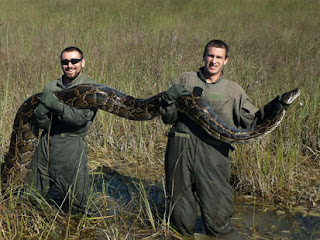Jeff Fobb is a Miami-Dade firefighter, but he’s also a snake hunter when he needs to be.
“I once caught a 14-foot python in a residential area, and about once a month I go out looking for them,” he said.
Fobb and the many newly enlisted snake hunters of South Florida are dealing with an invasion of an animal native to Asia that according to a just released study is increasingly threatening the wildlife of one of America’s largest and most precious eco-systems, the Florida Everglades.
“It’s hard to put your finger on how many there are out there, but I would argue … the acceptable number of pythons in the Everglades is zero,” Fobb said. “But now it’s a matter of management rather than elimination. There are so many areas we can’t penetrate.”
See images of pythons invading the Everglades and attempts to control them.
The Everglades, which stretch from near Orlando and to the southern tip of the state, is one of the largest wetland systems in the world. It is home to rabbits, raccoons, various species of birds, alligators and snakes — including the unwelcome and alien Burmese python.
“They [pythons] were purposely brought here for commerce and now they are living well in the wild. We have seen even alligators successfully consumed by them,” Everglades National Park wildlife biologist Skip Snow said. “There is a shift in what has been seen, and the great concern with biologists like myself is we have little understanding of how significant all of this is.”
According to a study published Monday in the Proceedings of the National Academy of Scientists, sightings of medium size mammals are down dramatically — as much as 99 percent in some cases in areas where pythons and other non-native constrictors are known to lurk.
“We hear from campers that we used to be harassed by raccoons and now people say there are none. Where are they?” Snow said.
Pythons can live up to 35 years and have anywhere from eight to 100 eggs, with the average female reproducing every other year. It is estimated that there are tens of thousands now in the Everglades.
Florida officials have set up a hotline — 1-888-IveGot1, a web site — Ivegot1.org, and an Ivegot1 smart phone app, all aimed at training the public about what to look out for. There is even free online training that people can take to accurately identify Burmese pythons.
“No other state is as interested in invasive animals as we are,” said Cheryl Millett, a biologist who periodically runs a course aimed at training people how to catch them. “There are a lot of pythons out there. They are having an impact on the wildlife, and they do affect people but it’s not like you are likely to encounter one when you get out the door.”
Fobb also helps train others on how to successfully catch the animals. But most of the time he actually goes out into the wetlands himself to catch them in their unnatural habitat.
“We follow roadways to cover a lot more areas. Visual searches in natural areas are very difficult. They are evolved to hide from people,” Fobb said. ”But it’s a lot about being at the right place at the right time. When they are approached by a predator their first instinct is to freeze. But they then go into a flight posture and use their camouflage to flee or they fight.”
Fobb said it’s a game of predator vs. predator, and the pythons are acutely aware of everything going on.
“I try to get them into flight mode. … It takes patience. Some defend themselves far more distantly,” he said. “They strike, so I like them to move away from me so I can pin their head and bag them up. I like that process, so you are not trying to get an animal that is trying to get you at the same time.”
But python hunters know that despite their increasingly high numbers, there is no guarantee that one will be caught during what they call a python survey.
“You can be standing right on top of one of the animals with grass six inches tall and see not see them,” Fobb said. “It’s amazing. It’s a testament to their ability to survive.”
It’s the survival of the other animals in the Everglades though that has most biologists concerned.
“We are at the very beginning of a steep learning curve. We don’t really know how the food web might respond,” Snow said. “If rabbits are in short supply, how will the bobcat, for instance, compensate. Will they eat something else? Will they move? What will happen to the animals that we can’t see? The real question is while we struggle to understand the impacts, what we really need to do is learn from this event and make sure it doesn’t happen again.”
http://abcnews.go.com


No comments:
Post a Comment
You can comment here...